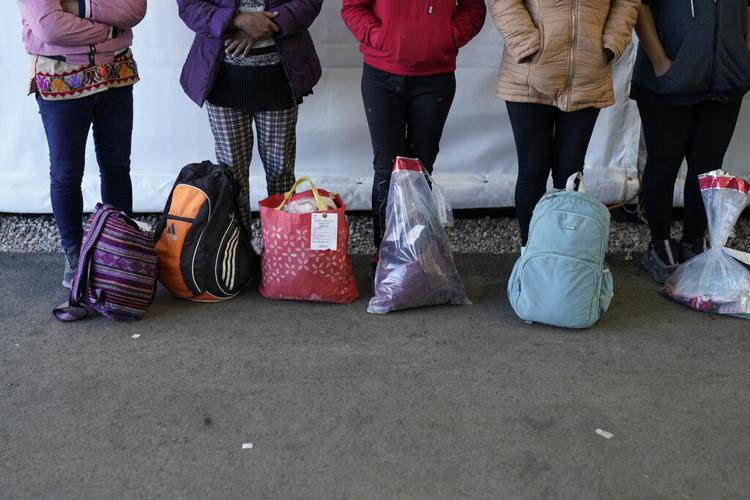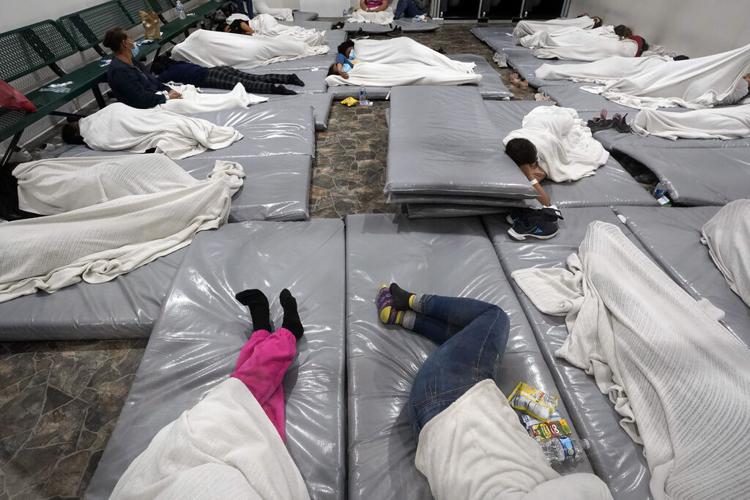A new study from the Migration Policy Institute details eight recommendations to improve U.S. immigration enforcement and management, in light of a rapidly evolving reality at the southern border.
Current U.S. immigration policy was largely established before a major demographic shift in migration trends, moving from mostly single, male Mexican nationals in the 2000s and earlier, to a larger proportion of families hailing from around the world in recent years.
That means the outdated immigration system is not well-equipped to handle today’s border conditions, said Colleen Putzel-Kavanaugh, report co-author and associate policy analyst at the D.C.-based Migration Policy Institute, or MPI, a nonprofit think tank that aims to improve immigration policies through research and analysis.
Recommendations in the report released Thursday include U.S. collaboration with other countries to improve migrant protections and boost their ability to receive asylum seekers; more reliable funding streams for U.S. border communities that initially aid asylum seekers, and separate funding for interior cities where asylum seekers settle; as well as resources for U.S. immigration courts to help chip away at a massive backlog preventing the U.S. from quickly removing many who don’t qualify for asylum.

Women wait in a hallway in December 2023 at a Border Patrol station in Ajo.
The report’s authors visited border cities in the United States and Mexico, interviewing U.S. border agents and port-of-entry officers in six border sectors, as well as local leaders and non-governmental organizations, to understand the day-to-day work and the challenges facing these groups. Their report, “Shifting Realities at the U.S. Mexico Border,” was also informed by feedback from stakeholders interviewed in southern Mexico, Guatemala, Costa Rica and Washington, D.C.
Shadowing border agents in their daily operations was illuminating, Putzel-Kavanaugh said.

Women wait in a Border Patrol holding facility in Tucson in December 2023.
“These agents are really responding in real time to constant changes, and their mission over the last couple of years has really shifted,” she said. “That’s because of the changes in flows that we’ve seen, particularly the heightened number of migrants, but also a diversity of nationalities and an increase of families, including children. … I think that sentiment toward (creating) a system that works better is shared among those agents, as it is amongst members of Congress and people who work on immigrant rights campaigns.”
The report’s recommendations also include the creation of multi-agency border processing centers housing representatives from relevant U.S. agencies, including U.S. Customs and Border Protection, Immigration and Customs Enforcement, Citizenship and Immigration Services, and the Office of Refugee Resettlement, as well as staff from local nongovernmental organizations and legal advocates.
“Right now what happens is that ICE may have an office at some Border Patrol processing centers, but not all. So much of this has to do with space and capacity. We think that to most efficiently process people at the border, it makes sense to house all of these institutions together in one place,” Putzel-Kavanaugh said.
National negotiations ongoing
The MPI report’s authors hope their analysis and suggestions will help U.S. legislators better understand the changing dynamics at the border, as well as the effect of the Biden administration’s “ambitious” set of border policies and why those policies’ impact has been so limited thus far.
For example, the “Circumvention of Lawful Pathways” rule — which legal advocates have challenged in courts — replaced the pandemic-era Title 42 policy, which allowed border agents to expel migrants without giving them a chance to request asylum, due to the COVID-19 health emergency.
Under Biden’s new rule, sometimes called the “asylum ban,” the only legitimate way for most migrants to enter the U.S. to apply for asylum requires an appointment scheduled through the “CBP One” application. The app has been criticized for bugs and its shortage of appointments, leaving asylum seekers waiting for months in dangerous conditions in Mexico, where they’ve been subject to extortion, kidnapping, assault and even torture. Those who fail to use the application to enter the U.S. are subject to at least a five-year bar on re-entry.
But without more resources for the immigration court system, which now has a backlog of 3 million cases, many who would be removed under the Circumvention of Lawful Pathways rule won’t face those consequences for five years or more, when their asylum hearing is scheduled, Putzel-Kavanaugh said.
“Many people are being released into the country, but they will not see their day in court until years down the line,” she said. “One of the points we’re trying to make in this report is that there’s been a lot of things done at the border itself, in the short term, to deal with these issues. … But the immigration system at large needs to be treated as a system, and that includes the immigration courts.”
The report also calls for increasing capacity at ports of entry, so as more migrants utilize the CBP One application, port officers are able to handle the flow without disrupting regular port operations that are vital to the U.S. economy.
Partnership with enforcement, NGOs
The report recommends more formalized agreements between CBP and non-governmental organizations, like Casa Alitas in Tucson, to allow for information sharing, as well as to facilitate timely communication about asylum seekers released from Border Patrol custody.
In Southern Arizona, county officials and aid groups say they have a good relationship with the Border Patrol, and communication has been key to their ability to manage unusually high volumes of migrant releases in recent months and to avoid asylum seekers being left unsheltered overnight in border communities.
But more formal agreements would be a welcome reform, said Diego Piña Lopez, agency director for Tucson nonprofit Casa Alitas, which provides temporary shelter and support services for asylum seekers.
Casa Alitas is a central part of Pima County’s migrant-aid system which has been able to manage more than 1,000 daily arrivals of migrants released as legal asylum seekers by border agents in recent months. While that number has recently dipped to “several hundred” a day, arrival volumes are always in flux and close communication with the Border Patrol would help NGOs better allocate resources, he said.
Sharing information would also save hours that Casa Alitas’ intake staff must spend questioning migrant arrivals to glean information that the Border Patrol has already recorded, Piña Lopez said. Even a five-minute intake screening adds up to hours of staff time, when the number of guests approaches 1,000 per day, he said.
“The bottleneck for us was definitely the intake,” he said. “Why do we have to ask the same questions that Border Patrol just asked, if we can work together?”
Pima County Supervisor Adelita Grijalva said on Wednesday that she’s been pushing for some kind of memorandum of understanding between CBP and local aid groups for that very reason. But Grijalva said that, during a visit to D.C. late last year, she heard from Arizona Sen. Kyrsten Sinema that she’d investigated that possibility and was told there were legal barriers to any kind of information-sharing agreement between government agencies and non-governmental groups.
“We thought it was a great idea, but in Washington they said there’s no way that’s going to happen,” Grijalva said.
Most asylum seekers released in border communities like Tucson only stay a night or two before traveling to sponsors or family in the interior of the U.S. But some migrants arrive without having U.S. connections, Putzel-Kavanaugh said.
The MPI report recommends that those asylum seekers without U.S. ties could be directed to cities with labor needs that would welcome the help, rather than transported to big cities that have recently been overwhelmed by high volumes of arrivals.
“What we’re seeing is a huge impact on these large cities like New York and Chicago, yet we have other cities in the U.S. who say, ‘We want workers. We want people to come here.’ We believe there should be something akin to the refugee system, whereby NGOs on the border can help place migrants in the interior” through coordination with those cities, Putzel-Kavanaugh said.
Stable local funding urged
The report also highlighted NGOs’ desire to return to a competitive-grant funding model, instead of the new allocation model that operates like a fee-for-service mechanism, Putzel-Kavanaugh said.
Under the Federal Emergency Management Agency’s Shelter and Services Program, in effect as of this month, NGOs now face more limitations on how they can use their federal funding, local officials say.
The $12 million allocation to the Pima County migrant-aid network was supposed to last through May but is on track to be used up by the end of February. That’s left local leaders lobbying Congress for more funding and scrambling for alternate ways to avoid unsheltered street releases of asylum seekers in Tucson.
The new funding model is an “extra burden on us. We have to be able to pivot almost on a dime,” Piña Lopez of Casa Alitas said. “Truth be told, I think (the new funding system) makes being the best stewards of the funding much harder to accomplish. But we’re always going to live with a lack of predictability until we have comprehensive immigration reform.”
U.S. legislators have been debating immigration reforms for weeks, in contentious negotiations that have immigrant-rights advocates worried for the future of the U.S. asylum system.
Most of the reforms under discussion at the federal level are focused on the enforcement side and restricting access to asylum, but neglect crucial backend aspects of the system that are necessary for success, Putzel-Kavanaugh said.
“The border control and asylum systems are inextricably linked,” she said. “We really want the public to understand that fixing one doesn’t fix the other. They both need to be fixed simultaneously.”
Some of the reforms under discussion at the federal level aim to reduce the number of asylum seekers released into the U.S., by raising the standard for what constitutes a “credible fear” of return to one’s country of origin. Credible-fear interviews with U.S. Citizenship and Immigration Services officers can be conducted via telephone or video at Border Patrol facilities after migrants are taken into custody, or for some they happen later on during their asylum hearings.
Border Patrol processing centers aim to minimize detention time for vulnerable groups such as families and unaccompanied children, so credible-fear interviews are now only being given to single, Spanish-speaking adults in Border Patrol custody, “which is likely the minority of people coming to the border,” Putzel-Kavanaugh said.
All migrants released into the U.S. undergo a background check and verification of documents, if they have them.
“More people are turning themselves in to Border Patrol and trying to make a protection claim, but the number of people initially placed in expedited removal is quite low, compared to people issued a notice-to-appear (at an asylum hearing in the future) and released, mainly because we’re seeing so many more families,” Putzel-Kavanaugh said. “Even some of these negotiations that are happening in Congress aren’t really getting to the heart of the issue of what’s actually happening on the ground.”
Get your morning recap of today's local news and read the full stories here: tucne.ws/morning








